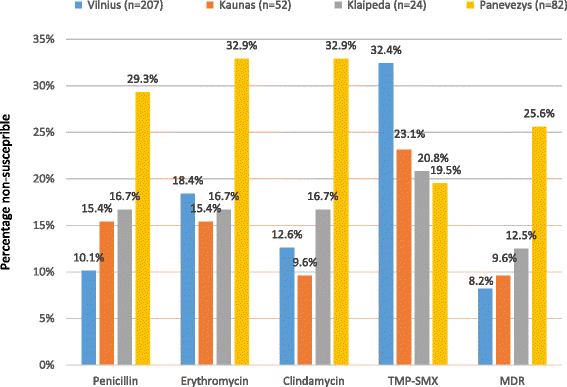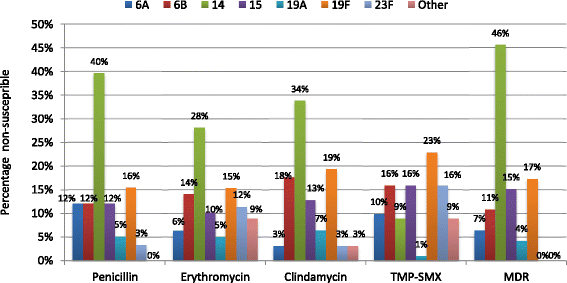Antibiotic resistance of Streptococcus pneumoniae, isolated from nasopharynx of preschool children with acute respiratory tract infection in Lithuania
- PMID: 27206423
- PMCID: PMC4875676
- DOI: 10.1186/s12879-016-1544-9
Antibiotic resistance of Streptococcus pneumoniae, isolated from nasopharynx of preschool children with acute respiratory tract infection in Lithuania
Abstract
Background: Increasing pneumococcal resistance to commonly used antibiotics and multidrug resistance is a serious public health concern. Data on distribution of resistant Streptococcus pneumoniae (SPn) strains among children in Lithuania are limited. We evaluated the circulation of SPn serotypes and antimicrobial susceptibility among preschool children in Lithuania before the introduction of universal infant pneumococcal vaccination.
Methods: A prospective study was carried out from February 2012 to March 2013 in five cities of Lithuania. A total of 900 children under six years of age who presented to primary care centre or a hospital emergency department with acute respiratory tract infection were enrolled in the study. Nasopharyngeal swabs were obtained and cultured for SPn. Positive samples (n = 367) were serotyped and tested for antimicrobial susceptibility. Associations of pneumococcal non-susceptibility with study site, season, age, sex, attendance of day care centre and treatment with antimicrobials (between one and six months prior the study) were evaluated.
Results: About a half (56.7 %) of SPn strains were susceptible to all the antibiotics tested. Pneumococcal non-susceptibility to penicillin, erythromycin, clindamycin and trimethoprim-sulphamethoxazole was 15.8, 21.3, 16.9 and 27.3 %, respectively. None of the tested isolates was resistant to norfloxacin or vancomycin. We found a geographical variation of pneumococcal resistance within the cities of the country. Age, sex, the attendance of day care centre and treatment with antimicrobials prior the study was not significantly associated with a carriage of non-susceptible SPn strains. Among non-susceptible SPn serotypes 67.9 %-82.4 % were present in currently available pneumococcal conjugate vaccines.
Conclusions: The rates of nasopharyngeal SPn susceptibility to penicillin and macrolides are still high among preschool children in Lithuania, however they are lower compared with previous studies. A strict policy with respect to antibiotic prescription together with widespread use of vaccination could potentially reduce the carriage rate of antibiotic-resistant pneumococci in our country.
Keywords: Antibiotic resistance; Nasopharyngeal colonization; Preschool children; Respiratory tract infection; Streptococcus pneumoniae.
Figures


Similar articles
-
Nasopharyngeal carriage of community-acquired, antibiotic-resistant Streptococcus pneumoniae in a Zambian paediatric population.Bull World Health Organ. 1997;75(5):453-62. Bull World Health Organ. 1997. PMID: 9447779 Free PMC article.
-
Pneumococcal carriage and antibiotic susceptibility patterns from two cross-sectional colonization surveys among children aged <5 years prior to the introduction of 10-valent pneumococcal conjugate vaccine - Kenya, 2009-2010.BMC Infect Dis. 2017 Jan 5;17(1):25. doi: 10.1186/s12879-016-2103-0. BMC Infect Dis. 2017. PMID: 28056828 Free PMC article.
-
Antibiotic-resistant Streptococcus pneumoniae in the heptavalent pneumococcal conjugate vaccine era: predictors of carriage in a multicommunity sample.Pediatrics. 2003 Oct;112(4):862-9. doi: 10.1542/peds.112.4.862. Pediatrics. 2003. PMID: 14523178
-
Management of antibiotic-resistant Streptococcus pneumoniae infections and the use of pneumococcal conjugate vaccines.Clin Microbiol Infect. 2009 Apr;15 Suppl 3:4-6. doi: 10.1111/j.1469-0691.2009.02723.x. Clin Microbiol Infect. 2009. PMID: 19366362 Review.
-
Antimicrobial resistance in paediatric Streptococcus pneumoniae isolates amid global implementation of pneumococcal conjugate vaccines: a systematic review and meta-regression analysis.Lancet Microbe. 2021 Sep;2(9):e450-e460. doi: 10.1016/S2666-5247(21)00064-1. Lancet Microbe. 2021. PMID: 34485957 Free PMC article.
Cited by
-
Children with respiratory tract infections in Swedish primary care; prevalence of antibiotic resistance in common respiratory tract pathogens and relation to antibiotic consumption.BMC Infect Dis. 2017 Sep 4;17(1):603. doi: 10.1186/s12879-017-2703-3. BMC Infect Dis. 2017. PMID: 28870173 Free PMC article.
-
Serotypes and Antimicrobial Susceptibility of Nasopharyngeal Isolates of Streptococcus pneumoniae from Children Less Than 5 Years Old in Egypt.Infect Drug Resist. 2020 Oct 19;13:3669-3677. doi: 10.2147/IDR.S250315. eCollection 2020. Infect Drug Resist. 2020. PMID: 33116686 Free PMC article.
-
Seasonality of antimicrobial resistance rates in respiratory bacteria: A systematic review and meta-analysis.PLoS One. 2019 Aug 15;14(8):e0221133. doi: 10.1371/journal.pone.0221133. eCollection 2019. PLoS One. 2019. PMID: 31415656 Free PMC article.
-
Throat Swab Culture Positivity and Antibiotic Resistance Profiles in Children 2-5 Years of Age Suspected of Bacterial Tonsillitis at Hargeisa Group of Hospitals, Somaliland: A Cross-Sectional Study.Int J Microbiol. 2023 Apr 5;2023:6474952. doi: 10.1155/2023/6474952. eCollection 2023. Int J Microbiol. 2023. PMID: 37065723 Free PMC article.
-
Etiology of pediatric lower respiratory tract infections in South Korea.Hum Vaccin Immunother. 2022 Nov 30;18(5):2048579. doi: 10.1080/21645515.2022.2048579. Epub 2022 Mar 28. Hum Vaccin Immunother. 2022. PMID: 35344458 Free PMC article.
References
-
- World Health Organization (WHO). Estimated Hib and pneumococcal deaths for children under 5 years of age, 2000. http://www.who.int/immunization/monitoring_surveillance/burden/estimates.... Accessed 16 May 2016.
-
- World Health Organization (WHO). Estimated Hib and pneumococcal deaths for children under 5 years of age, 2008. http://www.who.int/immunization/monitoring_surveillance/burden/estimates.... Accessed 16 May 2016.
MeSH terms
Substances
LinkOut - more resources
Full Text Sources
Other Literature Sources
Medical

